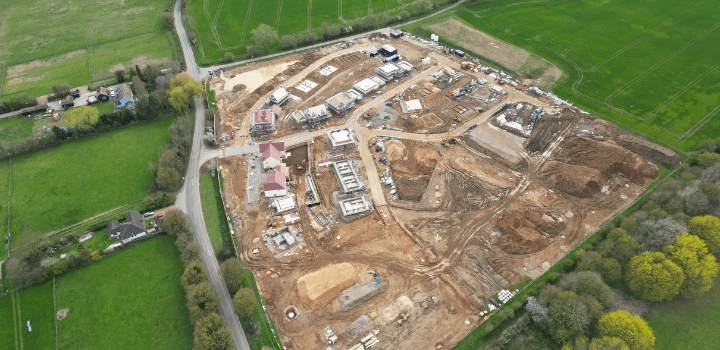Planning is often said by governments to block the building of new homes, renewable energy projects and transport infrastructure, hindering economic growth. And this government is no different. Keir Starmer vowed to “rip up” the bureaucratic planning system, but history tells us that planning reforms don’t lead to dramatic results on their own.
Worryingly, some of the red tape the government wants to ditch is environmental protections, such as environmental impact assessments, which are a vital measure in mitigating and reducing the risks of biodiversity loss. With UK nature in crisis, we can’t afford to lose more and should be using planning powers to help reverse the decline.
Providing more housing isn’t one of the government’s five headline missions, but it is central to the growth mission and important in addressing one of the big election issues. So, the government has set an ambitious target to build 1.5 million homes in the next five years, and established a New Towns Taskforce which will propose locations for another generation of new towns next year.
With the government’s sights set on housebuilding, Deputy Prime Minster and Secretary of State for Housing, Communities and Local Government Angela Rayner’s July statement detailed planning reforms to “turbocharge growth and build more homes”, including changes to the National Planning Policy Framework (NPPF).
We need building in the right places and the right way The NPPF provides overarching guidance for local authorities. The headline change was for local authorities not to reject housing developments due to lack of space, as parts of the green belt will now be freed up for development. Building more homes is of course needed but building them on green belt alone won’t get to the heart of the UK’s housing crisis.
We submitted a consultation response to the changes proposed, covering a broad range of environmental issues which, in summary, made the following points.
Freeing up green belt for development risks undermining its purpose to support urban regeneration. Brownfield sites should be prioritised over green, even if that is inconvenient and more costly for developers. Further guidance on what is intended, and a stronger ‘grey belt’ definition is required to prevent decisions doing irreversible harm to valuable green areas.
Development on green belt risks low density sprawl and creating car dependent communities. The alternative is to densify existing towns and cities. Higher density doesn’t have to mean high rise but could follow the European style of six to seven storey terraced ‘townhouses’, popular in Glasgow, Edinburgh and London. Higher density development reduces emissions and lowers energy demand. And denser communities are better connected, giving residents’ easier access to amenities and public transport networks.
Housing and transport: the missing link The NPPF reforms don’t consider the consequences of the changes proposed for transport. Significant new road development around new housing should be avoided, as road capacity breeds more traffic, undermining efforts to cut greenhouse gas emissions. Transport is already the UK’s highest emitting sector. And new roads are also poor value for money. A ‘no net traffic increase’ test for new housing developments should be explored. Alternatively, developments should be placed in the vicinity of existing public transport and active travel infrastructure, with amenities within walking or wheeling distance. Ensuring this first means the number of parking spaces available can be limited on new housing developments, providing more space for communities, rather than cars.
We support the proposal to increase the threshold of energy generated from onshore wind and solar projects before entering the Nationally Significant Infrastructure Project process, making more renewable projects quicker to deliver via the local planning system.
Still favouring onshore oil and gas development is wrong However, one disappointment is that the NPPF reform hasn’t proposed changing its presumption in favour of onshore oil and gas development. This is surprising, in the light of the recent Supreme Court decision in Finch vs Surrey County Council that ruled emissions as a consequence of oil and gas extraction should be accounted for in planning decisions. We’ve suggested this to be changed to a presumption against fossil fuel extraction.
The NPPF should set a clear direction in relation to housebuilding and the UK’s aims to reverse nature’s decline. For instance, by avoiding sites protected for their national or international significance and requiring developments to include high quality nature rich spaces. In relation to this, we suggest the NPPF should deter development on peatlands, unless it allows rewetting and does not detrimentally impact the wildlife.
Climate adaptation is missing In general, adaptation to climate change should be given greater weight in planning policy. It should make sure homes are fit for future. For example, all new properties have access to electric vehicle chargers and be designed to cope well with heatwaves.
Although there are some positive changes in the NPPF, simply changing planning permissions won’t, in itself, guarantee 1.5 million new homes are built in the next five years. The UK’s housing supply issues, exacerbated by and contributing to widening wealth inequality, have been decades in the making. Other bold solutions and investment are needed to get to the heart of this.
- Targets should make sure good quality affordable homes and social housing are built, in favour of more expensive properties, by introducing targets.
- Broader tax changes should address wealth inequality.
- And we can’t achieve better planning without more planners. Twenty five per cent of planners left the public sector between 2013-20, draining the UK of the expertise it needs to approve the higher volume of planning applications expected.
A more holistic view of the intertwined systems should support the multiple needs planning serves: increased affordable and social housing supply, a fast energy revolution, climate action, nature recovery and to lessen inequality.
Discover more from Inside track
Subscribe to get the latest posts sent to your email.
